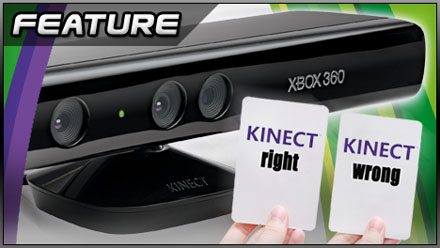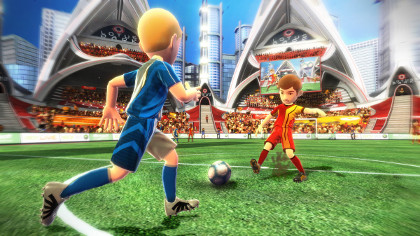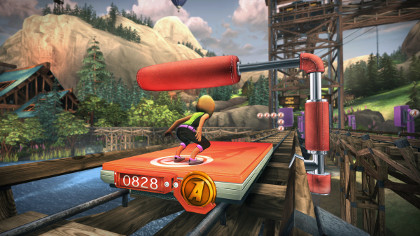
Developers hate Kinect. No really, they utterly loathe it. We can see it in their eyes, detect it in the tightening of the skin around their mouths, smell it on their breath. They were told that Microsoft’s ‘controller-less’ peripheral would turn the industry on its head, that it would flatten horizons, cancel learning thresholds, revitalise every gaming genre under the sun – and lo, They Believed. But then came the disappointments. No built-in processor. No four player modes. No ‘lie prone’ mechanic. And there was much wailing and gnashing of teeth.
Granted, you have to read between the lines to get at the wailing and gnashing. When Frontier Development’s David Braben shrugs in response to the question ‘can I sit down to play Kinectimals?’, for instance, it’s obvious that the implied sentiment is: ‘No, because the silly muppets forgot to account for the single most basic piece of player behaviour in the universe. Their stupid EyeToy rip-off is going south like a horde of cokehead lemmings, and I don’t plan on being there when the bodies start to fall.’
A more uplifting outlook is possible, however. Having kicked back at successive press events with both Microsoft’s own Kinect games and those of Ubisoft, we say: ask not, developers, what Kinect can do for you, ask what you can do for (or rather, with) Kinect. Innovation always has its risks, its compromises: the whole point is to think outside your comfort zone. There will be headaches and heartaches, yes, but you know what, I bet Walter Scott didn’t complain of chilblains when he journeyed to the South Pole. ‘Course, he wound up dead. But you won’t, Mr Developer. Unless the unusual strain of standing up during beta tests proves too much for your mozzarella-caked arteries.
Truth is, for all the talk of ‘revolution’ and ‘pushing the envelope’ Kinect is like any piece of technology at heart, be it an abacus or an Apple Mac. There are things it does well, and things it does not-so-well. Here are a few ways developers can draw out the former.
Don’t rush
To begin with the blindingly obvious, Kinect isn’t so hot in the latency department. VGD’s first dalliance with Dance Central confirmed this widely reported truth: there was a naked-eye discrepancy between my spasmodic jiggles and the coloured body map in top right. Most estimates put lag in the range of 150 to 200ms, which is definitely the sort of figure that will earn you a swift mouthful of nickel in a high noon duel.
So developers, dial things down a bit. Steer clear of twitch-driven formulas like the online-oriented first-person shooter, and focus on more leisurely experiences like those offered by the turn-based board game Carcassone, or a non-combative survival horror title. (How about a port of Silent Hill: Shattered Memories, Konami?)
There are plenty of gaming archetypes that foster a thoughtful pace – even in Orc-bashing, terrorist-mashing circles, where the measure of a man’s worth is how many mouse-clicks he can cram into a single round of StarCraft. One unfortunate side-effect of the explosion last decade of online multiplayer is an overvaluing of speed. From the crispness of Forza’s gear shifts to the hundred-mile-an-hour zoom-locks of Modern Warfare, a snappy rapport between button press and on-screen action is now, for many, what distinguishes lightweight from ‘serious’ gaming. The RPG, once a singularly unhurried genre, has joined the race, with BioWare and Bethesda laying on the adrenaline in their most recent projects.
Kinect’s ‘shortcomings’ here could do much to remind us that great games needn’t depend on preternatural reaction times.
Don’t cripple the player
Though among the more rough-and-tumble of Microsoft’s launch titles, Kinect Adventures is never too arduous: it amplifies your movements slightly, converting gentle hops or tilts of the shoulder into wild leaps and dodges. This sort of cunning accentuation will be crucial if Kinect games are to be relaxing pastimes as well as energetic ones.







 Satoru Iwata Video Interview - the late Nintendo president spoke with Kikizo in 2004 as 'Nintendo Revolution' loomed.
Satoru Iwata Video Interview - the late Nintendo president spoke with Kikizo in 2004 as 'Nintendo Revolution' loomed. Kaz Hirai Video Interview - the first of Kikizo's interviews with the man who went on to become global head of Sony.
Kaz Hirai Video Interview - the first of Kikizo's interviews with the man who went on to become global head of Sony. Ed Fries Video Interview - one of Xbox's founders discusses an epic journey from Excel to Xbox.
Ed Fries Video Interview - one of Xbox's founders discusses an epic journey from Excel to Xbox. Yu Suzuki, the Kikizo Interview - we spend time with one of gaming's most revered creators.
Yu Suzuki, the Kikizo Interview - we spend time with one of gaming's most revered creators. Tetris - The Making of an Icon: Alexey Pajitnov and Henk Rogers reveal the fascinating story behind Tetris
Tetris - The Making of an Icon: Alexey Pajitnov and Henk Rogers reveal the fascinating story behind Tetris Rare founders, Chris and Tim Stamper - their only interview? Genuinely 'rare' sit down with founders of the legendary studio.
Rare founders, Chris and Tim Stamper - their only interview? Genuinely 'rare' sit down with founders of the legendary studio. The History of First-Person Shooters - a retrospective, from Maze War to Modern Warfare
The History of First-Person Shooters - a retrospective, from Maze War to Modern Warfare
Kinect should be used in shooters only to track head movement in a 3D Headset game, while the gamers uses the standard controller to play in the virtual reality. So all they have to come out with is a 3D headset and have the developers add head tracking and 3D.
I knew it Kinekt, or Nathal is smoke and Mirrors.
Nothing more. Kinekt will fail, next…
^ You don’t know it, you’ll never try it. You read the internet, you can find whatever you want on the internet, you can find plenty to tell you it’s shit, plenty to tell you it’s amazing…so you’ll pick a side, read and beleive the things you want to. But you won’t ever try it, which is fine.
Best article I’ve read on Kinect except for the testicle part. We could do without that. Nevertheless, I’m in agreement with most and especially after reading the tons of articles of those who have played with the device. This Kinect is going to fail.
The guy is leading it this hardware has questionable skills and success in the profession. The hardware is clearly limited and MS have little idea as to who it will be geared towards.
I’m going to chalk this one up like a RARE game. Looks good, plays okay but no one is interested since there is nothing great about it.